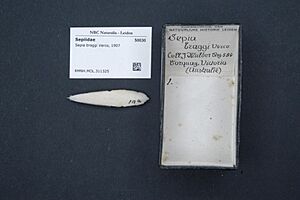Slender cuttlefish facts for kids
Quick facts for kids Slender cuttlefish |
|
|---|---|
| Conservation status | |
| Scientific classification | |
| Genus: |
Sepia
|
| Species: |
braggi
|
The Sepia braggi, also known as the slender cuttlefish, is a type of cuttlefish that lives in the Indo-Pacific Ocean. You can find it in the waters along the coast of southern Australia. This cuttlefish was first collected in South Australia by William Lawrence Bragg, who it is named after. Sir Joseph Cooke Verco officially described it in 1907. The slender cuttlefish belongs to a group called Doratosepion, which includes 41 different kinds of cuttlefish.
Contents
About the Slender Cuttlefish
The slender cuttlefish is a fairly small type of cuttlefish. Female cuttlefish are bigger than males. Females can grow to have a mantle (their main body) about 80 millimeters long. Males are smaller, with a mantle length of about 49 millimeters. The mantle is long and thin, shaped a bit like a cigar.
Narrow fins run along the sides of its body, getting wider towards the back. Its head is short and not as wide as its body. The cuttlebone (an internal shell) is usually about the same length as the mantle. The cuttlefish gets its common name, "slender cuttlefish," because its cuttlebone is long and thin, like a spearhead.
Its tentacle clubs are quite short and have five rows of suckers. Most suckers are about the same size, but 5 or 6 in the middle row are much larger. The suckers on its arms are tiny and spread out. Male cuttlefish have longer arms than females. Males' arms can be 35.2 to 57.8 millimeters long, while females' arms are 30.6 to 39.6 millimeters long. Unlike some similar species, the male slender cuttlefish does not have a special arm called a hectocotylus.
You can also identify this cuttlefish by its beak. The slender cuttlefish is the only one in the Sepia group that does not have a dark band on the sides of its upper and lower beak. Also, the dark part of its upper beak is much smaller than in other Sepia species.
What Colors Are They?
The head and body of the slender cuttlefish are a light brownish-pink color. Its fins are usually pale brown, and the ridges on its body can be orange-pink. What really makes the slender cuttlefish stand out are the short purple bars and blotches on its arms. This purple coloring is very unique and easy to see, even on young or small cuttlefish.
Where Do Slender Cuttlefish Live?
Slender cuttlefish live in Southern Australia, from southern New South Wales all the way to Western Australia. They are a demersal species, which means they live near the bottom of the ocean. You can usually find them in waters between 30 and 86 meters deep. One report suggests they might live as deep as 176 meters. However, cuttlefish found at very deep levels might sometimes be mistaken for other similar species like S. limata, S. rhoda, or S. vercoi.
Most cuttlefish in the Doratosepion group from southern and eastern Australia live in separate areas. However, the slender cuttlefish's home range does overlap a little with S. cottoni off southwestern Australia. The slender cuttlefish is one of three cuttlefish species known to live in Spencer Gulf in South Australia. Fishing boats that catch prawns sometimes find them there, but it's not very common.
What Do Slender Cuttlefish Eat?
Like other cuttlefish, S. braggi eats small crabs, other crustaceans (like shrimp), and fish. Sharks, large fish, and seals are known to hunt and eat cuttlefish. The Sepia apama and Sepia novaehollandiae are the main competitors for the slender cuttlefish. These two species are larger and more common, so they might compete for the same food and living spaces.
Slender Cuttlefish and Fishing
Slender cuttlefish are rarely seen and are quite small. Because of this, they are not considered a valuable catch for fishing. They are usually only caught by accident as by-catch when fishing boats are trying to catch other things.



